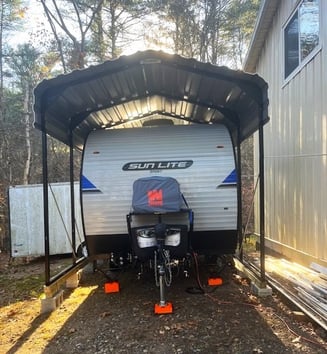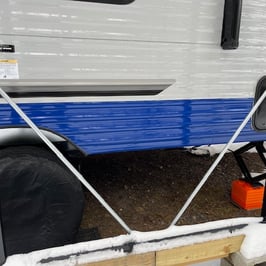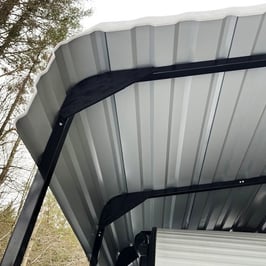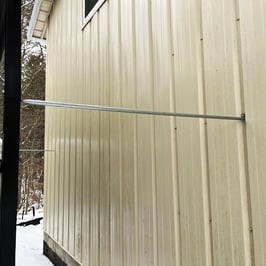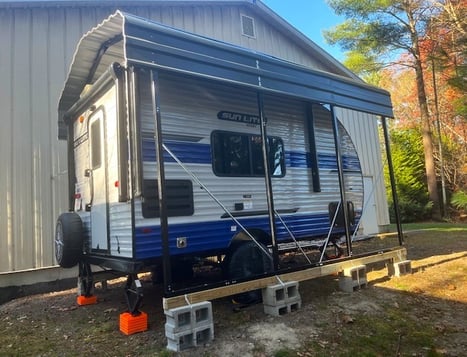

When it comes to storing your travel trailer during the off-season, you have a few options: using a tarp or fabric cover or investing in a carport. Unless you’re fortunate enough to have a garage that fits your trailer, building one or renting a storage unit can be costly. While both covers and carports provide protection, a carport offers several key advantages over a cover. Let’s explore why a carport is often the smarter, more practical choice for storing your travel trailer.
1. Protection from the Elements
A carport provides essential protection from weather conditions such as rain, snow, hail, and intense sunlight. These elements can damage your travel trailer over time—rain can lead to rust, snow can accumulate and cause structural issues and leaks, and UV rays can cause fading and deterioration of exterior finishes. A carport offers a roof over your trailer, shielding it from these harsh conditions while allowing proper ventilation. While covers do provide some protection, they can trap moisture underneath, leading to mold, mildew, and rust.
2. Affordability
When compared to building a fully enclosed garage or renting an indoor storage unit, a carport is a far more budget-friendly option. Carports are typically much cheaper to build or purchase, and there are plenty of affordable options that still provide excellent protection for your trailer. While the initial cost of a carport may be higher than a cover, it’s important to remember that covers wear out over time and need to be replaced regularly. In the long run, investing in a carport is a more cost-effective solution for protecting your trailer.
3. Easy Access
Unlike indoor storage units, where you may have to navigate tight spaces or deal with extra steps to access your travel trailer, a carport provides effortless, open access. Parking and retrieving your trailer is a breeze—no maneuvering, no hassle—saving you both time and frustration when it’s time to hit the road. Another major advantage of using a carport is the ease of access. With a cover, you must remove it each time you want to use your trailer, which can be both time-consuming and irritating. A carport eliminates that step, giving you quick and convenient access whenever you need it—whether you're heading out for a weekend getaway or just checking on your trailer. The open structure of a carport makes it simple to get in and out without any fuss.
4. Ventilation
Carports allow for better airflow compared to fully enclosed garages. This is particularly important for your travel trailer, as proper ventilation helps prevent moisture buildup inside the trailer, reducing the risk of mold, mildew, and rust. The open sides of a carport ensure your trailer gets the airflow it needs while still being protected from the elements.
5. Preventing Damage from Debris
A cover can easily collect debris such as leaves, dirt, twigs, and even branches, which, if left unchecked, can cause scratches, dents, or damage to your trailer’s exterior. In contrast, a carport provides a protective structure that keeps debris away from your trailer. With the open design of a carport, you’ll experience less accumulation of unwanted materials, which makes cleaning and maintenance significantly easier.
6. Long-Term Durability
Many carports are made from strong materials like steel or aluminum, offering durable and long-lasting protection. A well-constructed carport can withstand heavy winds, rain, and other weather events, ensuring your travel trailer remains safe and secure year-round. A cover, on the other hand, may degrade over time from UV exposure, wear and tear, or damage from wind and debris. With a carport, you can rely on years of reliable service without the need for frequent replacements or repairs.
7. Added Convenience
A major downside to using a cover is the effort involved in putting it on and securing it correctly. Covers can be cumbersome to handle, especially for larger trailers or in windy conditions. If the cover is too tight, it could rub against the trailer and cause scratches; if it’s too loose, it may shift, flap in the wind, or even get blown off entirely. A carport, however, offers a no-fuss solution—your trailer is always protected with minimal effort on your part. Once parked under the carport, you don’t have to worry about securing anything. It’s a convenient, easy-to-use storage solution.
8. Multi-Functional Space
A carport isn’t just for storing your trailer—it can also serve other purposes, such as providing a covered area for outdoor activities, a space for working on your trailer, or a shady spot for relaxation. Its versatility makes it a great investment for more than just storing your travel trailer.
9. Easy to Customize
Carports are customizable to fit your specific needs, whether you're looking for a basic, single-vehicle shelter or something larger to accommodate a travel trailer or RV. You can adjust the design, size, and materials to suit your preferences and budget, making it a flexible storage solution.
10. More Sustainable and Environmentally Friendly
Since a carport is built to last and provides better all-season protection, it can be considered a more environmentally friendly option than constantly buying new fabric covers. By investing in a long-lasting, durable structure, you reduce the need for replacing materials year after year, which ultimately reduces waste
Conclusion
When it comes to storing your travel trailer, a carport offers far more benefits than a cover and is a more budget-friendly alternative to indoor storage options. From year-round protection against the elements and better ventilation to ease of use, carports provide a convenient, durable, and low-maintenance solution. Plus, they give you quick access to your vehicle whenever you need it.
So, if you’re looking for a reliable and hassle-free way to protect your travel trailer, opt for a carport—you’ll thank yourself every season!
(I purchased my carport from Home Depot, and it’s a 10 ft. W x 15 ft. D x 9 ft. H model made by Arrow. Due to the rooftop AC unit on my trailer, I needed to raise the height of the carport for added clearance. To enhance stability and safety, I reinforced the carport with cross bracing, corner brackets, and anchored it securely to the adjacent building.)
